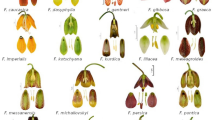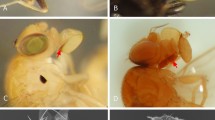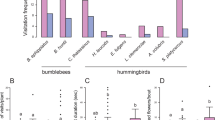Abstract
Angiosperm flowers have evolved a dazzling palette of colours and a rich bouquet of scents, principally serving to attract pollinators. Despite recent progress in the ecology of pollination, the sensory floral traits that are important for communication with pollinators (for example, colour and scent) have not been assessed in an unbiased, integrative sense within a community context. Nonetheless, floral sensory stimuli are known key factors that mediate flower visitation, thus affecting community dynamics. Here we show that flowers of the phrygana, a natural Mediterranean scrubland, display integrated patterns of scent composition and colour (as perceived by pollinators). Surprisingly, the data reveal predictive relationships between patterns of volatile composition and flower reflectance spectra. The presence of nectar is related to visual cues and the qualitative composition of floral aromas. Our results reveal a coordinated phenotypic integration consistent with the sensory abilities and perceptual biases of bees, suggesting potential facilitative effects for pollination and highlighting the fundamental importance of bees in Mediterranean-type ecosystems. We offer our unbiased approach as a starting point for more extensive, global investigations of the diversity of floral sensory phenotypes and its role in the community ecology of plant–pollinator interactions.
This is a preview of subscription content, access via your institution
Access options
Access Nature and 54 other Nature Portfolio journals
Get Nature+, our best-value online-access subscription
$29.99 / 30 days
cancel any time
Subscribe to this journal
Receive 12 digital issues and online access to articles
$119.00 per year
only $9.92 per issue
Buy this article
- Purchase on Springer Link
- Instant access to full article PDF
Prices may be subject to local taxes which are calculated during checkout





Similar content being viewed by others
References
Xiong, J., Fischer, W. M., Inoue, K., Nakahara, M. & Bauer, C. E. Molecular evidence for the early evolution of photosynthesis. Science 289, 1724–1730 (2000).
Rosenstiel, T. N., Shortlidge, E. E., Melnychenko, A. N., Pankow, J. F. & Eppley, S. M. Sex-specific volatile compounds influence microarthropod-mediated fertilization of moss. Nature 489, 431–433 (2012).
Smith, S. D. Pleiotropy and the evolution of floral integration. New Phytol. 209, 80–85 (2016).
Leonard, A. S., Dornhaus, A. & Papaj, D. R. in Evolution of Plant–Pollinator Relationships (ed. Patiny, S.) 279–300 (Cambridge Univ. Press, Cambridge, 2012).
Raguso, R. A. Wake up and smell the roses: the ecology and evolution of floral scent. Annu. Rev. Ecol. Evol. S. 39, 549–569 (2008).
Srinivasan, M. V., Zhang, S. W. & Zhu, H. Honeybees link sights to smells. Nature 396, 637–638 (1998).
Parachnowitsch, A. L., Raguso, R. A. & Kessler, A. Phenotypic selection to increase floral scent emission, but not flower size or colour in bee-pollinated Penstemon digitalis. New Phytol. 195, 667–675 (2012).
Hopkins, R. & Rausher, M. D. Pollinator-mediated selection on flower color allele drives reinforcement. Science 335, 1090–1092 (2012).
Murren, C. J. The integrated phenotype. Integr. Comp. Biol. 52, 64–76 (2012).
Armbruster, W. S., Pelabon, C., Bolstad, G. H. & Hansen, T. F. Integrated phenotypes: understanding trait covariation in plants and animals. Phil. Trans. R. Soc. B 369, 20130245 (2014).
Ben Zvi, M. M. et al. Interlinking showy traits: co-engineering of scent and colour biosynthesis in flowers. Plant Biotechnol. J. 6, 403–415 (2008).
Armbruster, W. S. Floral specialization and angiosperm diversity: phenotypic divergence, fitness trade-offs and realized pollination accuracy. AoB Plants 6, plu003 (2014).
Ordano, M., Fornoni, J., Boege, K. & Dominguez, C. A. The adaptive value of phenotypic floral integration. New Phytol. 179, 1183–1192 (2008).
Majetic, C. J., Raguso, R. A., Tonsor, S. J. & Ashman, T. L. Flower color–flower scent associations in polymorphic Hesperis matronalis (Brassicaceae). Phytochemistry 68, 865–874 (2007).
Kemp, D. J. et al. An integrative framework for the appraisal of coloration in nature. Am. Nat. 185, 705–724 (2015).
Petanidou, T. & Ellis, W. N. Pollinating fauna of a phryganic ecosystem: composition and diversity. Biodivers. Lett. 1, 9–22 (1993).
Kantsa, A. Mediterranean Odorscapes: The Role of Plants’ Volatile Organic Compounds in Pollination Networks. PhD thesis, Univ. Aegean (2016).
Chittka, L., Shmida, A., Troje, N. & Menzel, R. Ultraviolet as a component of flower reflections, and the colour perception of hymenoptera. Vision Res. 34, 1489–1508 (1994).
Briscoe, A. D. & Chittka, L. The evolution of color vision in insects. Annu. Rev. Entomol. 46, 471–510 (2001).
Dyer, A. G. et al. Parallel evolution of angiosperm colour signals: common evolutionary pressures linked to hymenopteran vision. Proc. R. Soc. B 279, 3606–3615 (2012).
Koshitaka, H., Kinoshita, M., Vorobyev, M. & Arikawa, K. Tetrachromacy in a butterfly that has eight varieties of spectral receptors. Proc. R. Soc. B 275, 947–954 (2008).
Petanidou, T. & Smets, E. The potential of marginal lands for bees and apiculture: nectar secretion in Mediterranean shrublands. Apidologie 26, 39–52 (1995).
Rohde, K., Papiorek, S. & Lunau, K. Bumblebees (Bombus terrestris) and honeybees (Apis mellifera) prefer similar colours of higher spectral purity over trained colours. J. Comp. Physiol. A 199, 197–210 (2013).
Poupkou, A. et al. Present climate trend analysis of the etesian winds in the Aegean Sea. Theor. Appl. Climatol. 106, 459–472 (2011).
Vereecken, N. J. et al. Pre-adaptations and the evolution of pollination by sexual deception: Cope’s rule of specialization revisited. Proc. R. Soc. B 279, 4786–4794 (2012).
Horovitz, A. Edaphic factors and flower colour distribution in the Anemoneae (Ranunculaceae). Plant Syst. Evol. 126, 239–242 (1976).
Lunau, K., Papiorek, S., Eltz, T. & Sazima, M. Avoidance of achromatic colours by bees provides a private niche for hummingbirds. J. Exp. Biol. 214, 1607–1612 (2011).
Slessor, K. N., Winston, M. L. & Le Conte, Y. Pheromone communication in the honeybee (Apis mellifera L.). J. Chem. Ecol. 31, 2731–2745 (2005).
Schiestl, F. P. & Johnson, S. D. Pollinator-mediated evolution of floral signals. Trends Ecol. Evol. 28, 307–315 (2013).
Martinez-Harms, J. et al. Evidence of red sensitive photoreceptors in Pygopleurus israelitus (Glaphyridae: Coleoptera) and its implications for beetle pollination in the southeast Mediterranean. J. Comp. Physiol. A 198, 451–463 (2012).
Dafni, A. et al. Red bowl-shaped flowers—convergence for beetle pollination in the Mediterranean region. Israel J. Bot. 39, 81–92 (1990).
Kantsa, A., Sotiropoulou, S., Vaitis, M. & Petanidou, T. Plant volatilome in Greece: a review on the properties, prospects, and chemogeography. Chem. Biodivers. 12, 1466–1480 (2015).
Blight, M. M. et al. Identification of floral volatiles involved in recognition of oilseed rape flowers, Brassica napus by honeybees, Apis mellifera. J. Chem. Ecol. 23, 1715–1727 (1997).
Raine, N. E. & Chittka, L. The adaptive significance of sensory bias in a foraging context: floral colour preferences in the bumblebee Bombus terrestris. PLoS ONE 2, e556 (2007).
Dudareva, N. & DellaPenna, D. Plant metabolic engineering: future prospects and challenges. Curr. Opin. Biotechnol. 24, 226–228 (2013).
Andersson, S., Nilsson, L. A., Groth, I. & Bergstrom, G. Floral scents in butterfly-pollinated plants: possible convergence in chemical composition. Bot. J. Linn. Soc. 140, 129–153 (2002).
Gershenzon, J. & Dudareva, N. The function of terpene natural products in the natural world. Nat. Chem. Biol. 3, 408–414 (2007).
Junker, R. R. & Blüthgen, N. Floral scents repel facultative flower visitors, but attract obligate ones. Ann. Bot. 105, 777–782 (2010).
Banks, J. A. et al. The Selaginella genome identifies genetic changes associated with the evolution of vascular plants. Science 332, 960–963 (2011).
Hansson, B. S. & Stensmyr, M. C. Evolution of insect olfaction. Neuron 72, 698–711 (2011).
Renoult, J. P., Valido, A., Jordano, P. & Schaefer, H. M. Adaptation of flower and fruit colours to multiple, distinct mutualists. New Phytol. 201, 678–686 (2014).
Sargent, R. D. & Ackerly, D. D. Plant–pollinator interactions and the assembly of plant communities. Trends Ecol. Evol. 23, 123–130 (2008).
Ashman, T. L. & Arceo-Gomez, G. Toward a predictive understanding of the fitness costs of heterospecific pollen receipt and its importance in co-flowering communities. Am. J. Bot. 100, 1061–1070 (2013).
Junker, R. R. & Parachnowitsch, A. L. Working towards a holistic view on flower—how floral scents mediate plant–animal interactions in concert with other floral characters. J. Indian I. Sci. 91, 43–67 (2015).
Armbruster, W. S. The specialization continuum in pollination systems: diversity of concepts and implications for ecology, evolution and conservation. Funct. Ecol. 31, 88–100 (2017).
Waser, N. M., Chittka, L., Price, M. V., Williams, N. M. & Ollerton, J. Generalization in pollination systems, and why it matters. Ecology 77, 1043–1060 (1996).
Hubbell, S. P. The Unified Neutral Theory of Biodiversity and Biogeography Vol. 32 (Princeton Univ. Press, Princeton and Oxford, 2001).
Kallimanis, A. S., Petanidou, T., Tzanopoulos, J., Pantis, J. D. & Sgardelis, S. P. Do plant–pollinator interaction networks result from stochastic processes? Ecol. Model. 220, 684–693 (2009).
Encinas-Viso, F., Revilla, T. A. & Etienne, R. S. Phenology drives mutualistic network structure and diversity. Ecol. Lett. 15, 198–208 (2012).
Bascompte, J., Jordano, P., Melian, C. J. & Olesen, J. M. The nested assembly of plant–animal mutualistic networks. Proc. Natl Acad. Sci. USA 100, 9383–9387 (2003).
Euro+Med PlantBase - The Information Resource for Euro-Mediterranean Plant Diversity (Euro+Med, Berlin-Dahlem, 2006); http://ww2.bgbm.org/EuroPlusMed/.
Kaiser, R. & Kraft, P. Neue und ungewöhnliche Naturstoffe faszinierender Blütendüfte. Chem. Unserer Zeit 1, 8–23 (2001).
Arnold, S. E. J., Faruq, S., Savolainen, V., McOwan, P. W. & Chittka, L. FReD: the floral reflectance database—a web portal for analyses of flower colour. PLoS ONE 5, e14287 (2010).
Shrestha, M., Dyer, A. G., Bhattarai, P., Burd, M. & Shefferson, R. Flower colour and phylogeny along an altitudinal gradient in the Himalayas of Nepal. J. Ecol. 102, 126–135 (2014).
Perry, M. et al. Molecular logic behind the three-way stochastic choices that expand butterfly colour vision. Nature 535, 280–284 (2016).
Stoddard, M. C. & Prum, R. O. Evolution of avian plumage color in a tetrahedral color space: a phylogenetic analysis of new world buntings. Am. Nat. 171, 755–776 (2008).
Bremer, B. et al. An update of the Angiosperm Phylogeny Group classification for the orders and families of flowering plants: APG III. Bot. J. Linn. Soc. 161, 105–121 (2009).
Webb, C. O. & Donoghue, M. J. Phylomatic: tree assembly for applied phylogenetics. Mol. Ecol. Notes 5, 181–183 (2005).
Webb, C. O., Ackerly, D. D. & Kembel, S. W. Phylocom: software for the analysis of phylogenetic community structure and trait evolution. Bioinformatics 24, 2098–2100 (2008).
Blomberg, S. P., Garland, T. Jr & Ives, A. R. Testing for phylogenetic signal in comparative data: behavioral traits are more labile. Evolution 57, 717–745 (2003).
Fritz, S. A. & Purvis, A. Selectivity in mammalian extinction risk and threat types: a new measure of phylogenetic signal strength in binary traits. Conserv. Biol. 24, 1042–1051 (2010).
Paleo-López, R. et al. A phylogenetic analysis of macroevolutionary patterns in fermentative yeasts. Ecol. Evol. 6, 3851–3861 (2016).
Wang, Y., Naumann, U., Wright, S., Eddelbuettel, D. & Warton, D. mvabund: Statistical Methods for Analysing Multivariate Abundance Data. R package version 3.11.9 (R Foundation for Statistical Computing, Vienna, 2016); https://CRAN.R-project.org/package=mvabund.
Wang, Y., Naumann, U., Wright, S. T. & Warton, D. I. mvabund—an R package for model-based analysis of multivariate abundance data. Methods Ecol. Evol. 3, 471–474 (2012).
Guimerà, R. & Nunes Amaral, L. A. Functional cartography of complex metabolic networks. Nature 433, 895–900 (2005).
Freckleton, R. P., Harvey, P. H. & Pagel, M. Phylogenetic analysis and comparative data: a test and review of evidence. Am. Nat. 160, 712–726 (1985).
Acknowledgements
This research was co-financed by the European Union (European Social Fund) and Greek national funds through the operational programme ‘Education and Lifelong Learning’ of the National Strategic Reference Framework – Research Funding Program: Heraclitus II (2324-1/WP17/30340). A.K. and T.P. are grateful to T. Lekkas, M. Aloupi, T. Tscheulin, P. Davies, T. Kallimanis, O. Davias, Korres S.A. Natural Products, O.-I. Kalantzi and P. Magiatis for multifaceted support.
Author information
Authors and Affiliations
Contributions
A.K. and T.P. designed the study. A.K. collected the data and performed chemical analyses. A.K., A.G.D., R.A.R. and S.P.S. analysed the data. The manuscript was written primarily by A.K. with major contributions by all other co-authors.
Corresponding author
Ethics declarations
Competing interests
The authors declare no competing financial interests.
Additional information
Publisher’s note: Springer Nature remains neutral with regard to jurisdictional claims in published maps and institutional affiliations.
Electronic supplementary material
Supplementary Information
Supplementary Figures and Supplementary Tables
Rights and permissions
About this article
Cite this article
Kantsa, A., Raguso, R.A., Dyer, A.G. et al. Community-wide integration of floral colour and scent in a Mediterranean scrubland. Nat Ecol Evol 1, 1502–1510 (2017). https://doi.org/10.1038/s41559-017-0298-0
Received:
Accepted:
Published:
Issue Date:
DOI: https://doi.org/10.1038/s41559-017-0298-0
This article is cited by
-
Coordination among flower pigments, scents and pollinators in ornamental plants
Horticulture Advances (2024)
-
Floral species evenness is the major driver of wild bee communities in urban gardens
Urban Ecosystems (2024)
-
Natural variation in Beauty Mark is associated with UV-based geographical adaptation in Gossypium species
BMC Biology (2023)
-
Floral and leaf-trap volatiles and their relationship to pollinator and prey attraction in Pinguicula moranensis (Lentibulariaceae)
Arthropod-Plant Interactions (2023)
-
Floral attractants in an alpine environment: linking floral volatiles, flower size and pollinators
Alpine Botany (2023)



